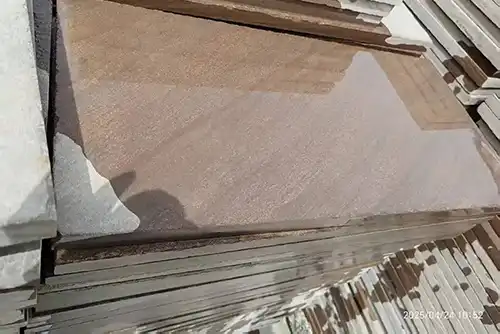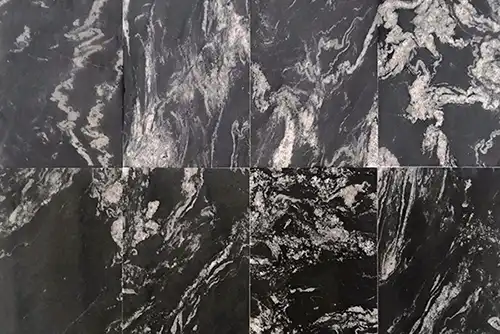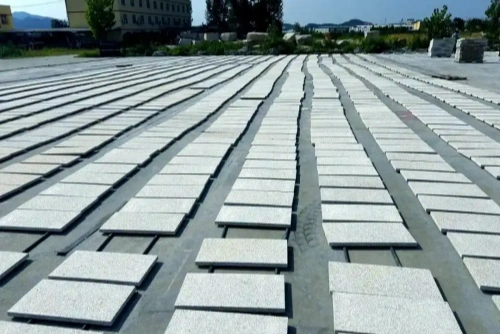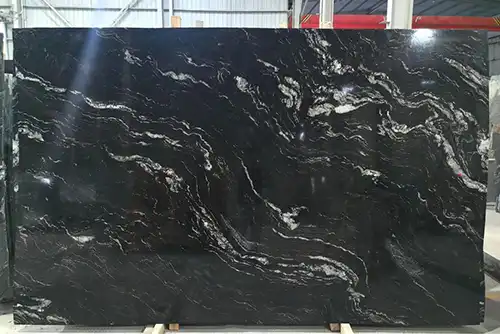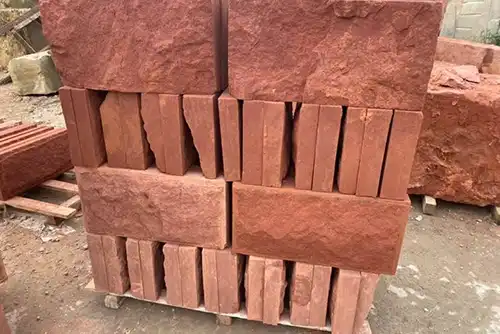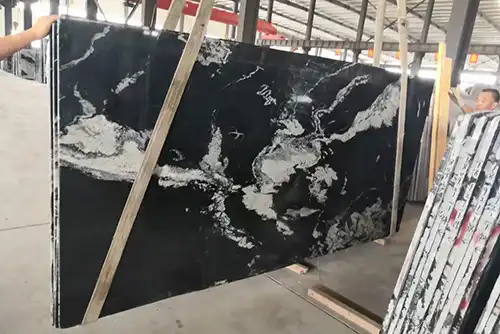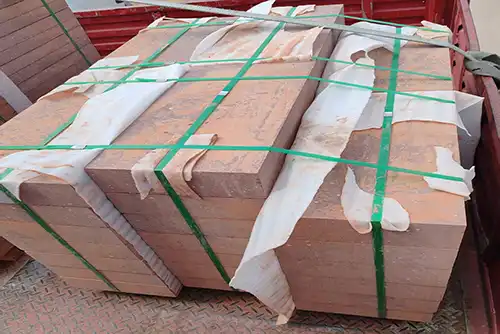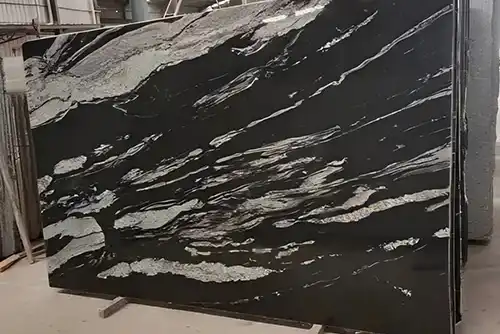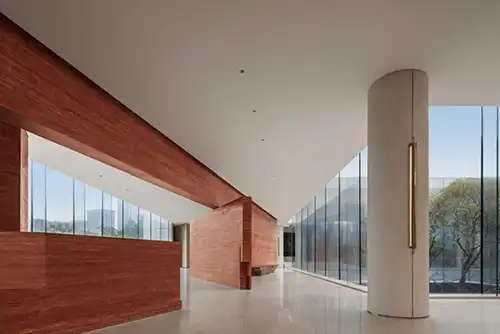Home / Knowledges
Knowledges
-
What Edge Profiles Work Best for Cosmic Black Stone Slabs?
When it comes to selecting the perfect edge profile for Cosmic Black Stone slabs, the choice can significantly impact the overall aesthetic and functionality of your project. Cosmic Black Stone, renowned for its deep black base and flowing texture, offers a unique blend of artistry and practicality that has made it a favorite in high-end architecture and interior design. The stone's captivating appearance, characterized by its deep black background interspersed with white and gray-gold filamentous textures, provides a stunning canvas for various edge profiles. Some variants even contain metal minerals, creating a mesmerizing "gold edge" effect that adds depth and visual hierarchy. Whether you're aiming for a minimalist modern look with clean lines or a more artistic, postmodern feel with free-flowing patterns reminiscent of oil paintings, the right edge profile can enhance the natural beauty of Cosmic Black Stone and elevate your design to new heights.VIEW MORE -
Can a Natural Red Sandstone Slab Work as a Kitchen Backsplash?
When it comes to kitchen design, the backsplash is a crucial element that can significantly impact the overall aesthetic and functionality of the space. While traditional materials like ceramic tiles and glass have long been popular choices, more homeowners are now exploring unique options to add character and warmth to their kitchens. One such option that has been gaining traction is the use of natural red sandstone slabs as kitchen backsplashes. This stunning material, known for its rich, earthy tones and distinctive texture, can transform an ordinary kitchen into a stunning showcase of natural beauty. But the question remains: Can a natural red sandstone slab work effectively as a kitchen backsplash? In this blog post, we'll explore the pros and cons of using this captivating stone in your kitchen, discuss its durability and maintenance requirements, and provide insights into how to incorporate it seamlessly into your kitchen design.VIEW MORE -
What Finishes Enhance Royal Ballet Granite in Interiors?
Royal Ballet Granite, a stunning natural stone, has captivated interior designers and homeowners alike with its elegant texture and versatile applications. This exquisite granite, known for its artistic appeal and practicality, has become a staple in high-end buildings and landscape projects. The interplay of black and white hues, accented by purple and gray-blue stripes, creates a mesmerizing flow reminiscent of gentle streams. Its adaptability to both modern minimalist and classical decoration styles makes it a sought-after choice for discerning clients. With variants like Baroque Black and Cosmic Black, which employ special processes to enhance color contrast and visual impact, Royal Ballet Granite offers a range of options to suit diverse aesthetic preferences. Its impressive durability, with a Mohs hardness of 6-7 and compressive strength exceeding 100MPa, ensures longevity and resistance to wear and freeze-thaw cycles, making it ideal for high-traffic areas. As we delve into the world of Royal Ballet Granite, we'll explore the various finishes that can enhance its beauty and functionality in interior spaces.VIEW MORE -
Can Dark Grey Granite Paving Slabs Withstand Heavy Vehicles?
Dark grey granite paving slabs have become increasingly popular in both residential and commercial landscaping projects due to their durability, aesthetic appeal, and versatility. As more property owners and developers consider using these elegant stones for their outdoor spaces, a common question arises: Can dark grey granite paving slabs withstand heavy vehicles? This is a crucial consideration, especially for areas that may experience frequent traffic from cars, trucks, or even industrial machinery. In this comprehensive blog post, we will explore the strength and durability of dark grey granite paving slabs, their ability to handle heavy loads, and the factors that contribute to their performance under pressure. We'll also discuss proper installation techniques, maintenance requirements, and real-world applications to help you make an informed decision about using these stunning natural stone products in your next project. Whether you're planning a residential driveway, a commercial parking lot, or a public plaza, understanding the capabilities of dark grey granite paving slabs is essential for ensuring long-lasting and functional results.VIEW MORE -
How Slip-Resistant Is Cosmic Black Stone for Indoor Wet Areas?
When it comes to selecting the perfect stone for indoor wet areas, slip resistance is a crucial factor that cannot be overlooked. Cosmic Black Stone, with its stunning deep black base and flowing texture, has become a popular choice for high-end architecture and interior design. But how does it perform in terms of slip resistance in wet conditions? This exquisite natural stone, known for its artistic appeal and practicality, offers more than just visual allure. Its unique surface characteristics, combined with proper finishing techniques, can provide a reliable and safe flooring option for various indoor wet areas. In this comprehensive guide, we'll explore the slip-resistant properties of Cosmic Black Stone, its applications in wet environments, and the factors that contribute to its performance in these challenging conditions. Whether you're considering this material for a luxurious bathroom, a high-end spa, or a commercial kitchen, understanding its slip-resistant capabilities is essential for making an informed decision.VIEW MORE -
How Do Natural Red Sandstone Slab Thermal Properties Benefit Interiors?
Natural red sandstone slabs have been a popular choice in architecture and interior design for centuries, prized for their rich, warm hues and unique textures. However, beyond their aesthetic appeal, these remarkable stone slabs offer a range of thermal properties that can significantly benefit interior spaces. The natural composition of red sandstone, with its porous structure and mineral content, contributes to its excellent heat retention and distribution capabilities. This inherent characteristic makes red sandstone slabs an ideal material for regulating indoor temperatures, providing a comfortable living environment throughout the year. As we delve deeper into the thermal properties of natural red sandstone slabs, we'll explore how they can enhance energy efficiency, reduce heating and cooling costs, and create a more sustainable living space. From its ability to absorb and slowly release heat to its natural insulation properties, red sandstone slabs offer a multitude of benefits that extend far beyond their visual appeal.VIEW MORE -
How Eco-Friendly Is Royal Ballet Granite for Interiors?
In the realm of interior design, the choice of materials plays a crucial role in both aesthetics and sustainability. As homeowners and designers increasingly prioritize eco-friendly options, the question arises: How eco-friendly is Royal Ballet Granite for interiors? This exquisite stone, known for its elegant texture and captivating patterns, has gained popularity in high-end buildings and landscape projects. Royal Ballet Granite, with its distinctive black and white coloration accented by purple and gray-blue stripes, offers a natural flow reminiscent of flowing water. Its versatility makes it suitable for both modern minimalist and classical decoration styles. While its beauty is undeniable, it's essential to examine the environmental impact of using this material in interior spaces. This article delves into the eco-friendliness of Royal Ballet Granite, exploring its production process, durability, and overall sustainability to help you make an informed decision for your next interior project.VIEW MORE -
What Color Schemes Pair Well with Royal Ballet Granite?
Royal Ballet Granite is a stunning natural stone that has captured the hearts of designers and homeowners alike. Known for its elegant texture and captivating blend of colors, this granite variety offers a unique canvas for creating sophisticated and harmonious interior spaces. The intricate patterns of Royal Ballet Granite, featuring a mesmerizing dance of black and white hues accented with purple and gray-blue striations, present both opportunities and challenges when it comes to color pairing. As we delve into the world of color schemes that complement this exquisite stone, we'll explore how to enhance its natural beauty while creating cohesive and visually appealing environments. Whether you're planning a kitchen renovation, a bathroom remodel, or considering Royal Ballet Granite for other applications, understanding the best color pairings will help you make informed decisions that elevate your space to new heights of elegance and style.VIEW MORE -
How Does a Natural Red Sandstone Slab Affect Indoor Acoustics?
Natural red sandstone slabs have long been admired for their aesthetic appeal in architectural and interior design. However, their impact on indoor acoustics is an often-overlooked aspect that deserves attention. These slabs, known for their rich, warm hues and unique textures, can significantly influence the sound quality within a space. The porous nature of red sandstone allows it to absorb sound waves to some extent, potentially reducing echo and reverberation in a room. This characteristic makes it an interesting option for those seeking to enhance the acoustic properties of their interiors while maintaining a natural, elegant appearance. Understanding how natural red sandstone slabs affect indoor acoustics can help architects, designers, and homeowners make informed decisions about incorporating this material into their projects, balancing both visual appeal and acoustic performance.VIEW MORE -
Is Cosmic Black Stone Suitable for Bathroom Vanity Tops?
When it comes to selecting the perfect material for bathroom vanity tops, homeowners and designers are often faced with a myriad of options. One material that has been gaining popularity in recent years is Cosmic Black Stone. This striking natural stone, known for its deep black base and flowing texture, offers a unique blend of elegance and practicality. As we delve into the world of Cosmic Black Stone, we'll explore its suitability for bathroom vanity tops, considering factors such as durability, aesthetics, and maintenance. Whether you're renovating your bathroom or building a new home, understanding the properties and benefits of Cosmic Black Stone can help you make an informed decision for your vanity top choice. Let's embark on this journey to discover if Cosmic Black Stone is indeed the ideal material for creating a stunning and functional bathroom vanity top.VIEW MORE -
How Does Cosmic Black Stone Affect Room Ambiance and Light?
Cosmic Black Stone, a captivating natural stone, has become increasingly popular in interior design and architecture due to its unique ability to transform room ambiance and lighting. This exquisite material, known for its deep black base and flowing texture, creates a mesmerizing interplay between light and shadow, elevating any space it graces. The stone's surface, adorned with white and gray-gold filamentous textures, reflects and absorbs light in intriguing ways, adding depth and dimension to rooms. Some variants even incorporate metal minerals, resulting in a striking "gold edge" effect that further enhances its visual appeal. Whether used in modern minimalist designs with clean lines or in postmodern art spaces with free-flowing, ink-splatter-like patterns, Cosmic Black Stone invariably becomes a focal point, dramatically influencing the overall atmosphere of a room. Its versatility allows it to seamlessly integrate into various design styles, making it a favorite among interior designers and homeowners alike who seek to create spaces that are both visually stunning and emotionally evocative.VIEW MORE -
What Makes a Natural Red Sandstone Slab Ideal for Interior Floors?
Natural red sandstone slabs have become increasingly popular for interior flooring, offering a unique blend of aesthetics and functionality that few other materials can match. These slabs, formed over millions of years from compressed sand and minerals, bring a touch of nature's artistry into our living spaces. Their warm, earthy tones ranging from deep reds to subtle pinks create a welcoming atmosphere, while their natural texture adds depth and character to any room. But what truly sets natural red sandstone slabs apart for interior floors goes beyond their visual appeal. Their durability, versatility, and low maintenance requirements make them an excellent choice for homeowners and designers alike. As we delve deeper into the qualities of these remarkable stone slabs, we'll discover why they've become a favorite for those seeking to create distinctive and lasting interior spaces.VIEW MORE
- 1
- 2
- 3
Total 3 pages
 信拓_1747705273728.webp)

